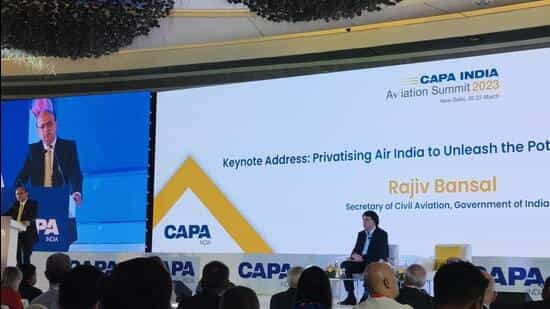NEW DELHI: The government has allowed Indian airlines to use foreign pilots for a short period in view of a shortage of pilots to operate the Boeing 777 aircraft, Union civil aviation secretary Rajiv Bansal said on Tuesday.
“The demand for 777 pilots is such that for the first time, after years, we are allowing Foreign Aircrew Temporary Authorization (FATA) pilots,” Bansal said at an aviation summit organised by aviation consultant Centre for Asia Pacific Aviation, or CAPA India.
“Normally we don’t allow foreign pilots. But currently, there is demand but there is no skilled competency available,” he said.
“I would go to the extent of saying that this demand has happened since the Air India privatization took place just a year back and that is why today, we don’t have any 777pilots available in the country, and hence we are resorting to taking foreign pilots for short time,” he said.
Air India, which was acquired by the Tata Group last year, announced on Monday that it will reduce at least six weekly flights to the United States due to crew shortages over the next 2-3 months.
, three to Newark and three to San Francisco, will be trimmed due to crew shortage for the coming 2-3 months,”
On the expansion of aviation infrastructure in the country, Bansal said that greenfield airports in Jewar and Navi Mumbai are expected to be inaugurated by December next year. “Both these projects are on track, and we hope to inaugurate them by November- December next year,” Bansal said.
He added that the government is also looking at raising the passenger capacity of the six metro airports at Delhi, Mumbai, Hyderabad, Bengaluru, Kolkata and Chennai from 320 million to 500 million.
In this context, he said that Delhi’s terminal one (T1) expansion work will be completed by August- September this year. “We hope that terminal 1 will expand and the three terminals at Delhi airport collectively will have a capacity of handling 100 million passengers per year,” the official said.
The airport’s fourth runway will get operational by August due to which the air traffic movements correspondingly increase, he said.
“ 100 million is a magic figure which puts you into a different league globally. This will be a great achievement for the country,” Bansal said.
“Now that we have the necessary infrastructure in place, and we have five or six reasonably big carriers in our country. I do feel that there is great scope in our country for growth in international connectivity”, he said.
“Our biggest challenge and our aspiration is to build world-class infrastructure ahead of the curve and we have always been behind the curve”, Bansal said on Tuesday.
“Now we’re trying to build ahead of the curve. We must be able to build infrastructure and build world-class infrastructure ahead of the curve that is a basic ingredient for our unique growth,” he said.
Bansal listed supply chain issues as one of the challenges facing the industry.
“Demand from consumers is very high… but aircraft manufacturers and engine manufacturers are not able to supply frames and engines. That is an area that the airframe manufacturers as well as the engine suppliers need to address,” he said.
Another challenge is that India doesn’t have a Maintenance Repair and Overhaul (MROs) scale in India due to which it takes months to ship out an engine to an MRO and get it back.
“We do need to have an MRO scale. Without which talk of these numbers of acquisition of fleet cannot sustain unless we are large MROs in India. The downtime will be so high that profitability will be impacted,” he said.
Bansal also said that the government is also in the process of disinvesting Air India Engineering Services Limited (AIESL), the country’s largest MRO in our country today which is making money.
“Once this disinvestment is completed hopefully in a couple of months from now, it will work well for the Indian civil aviation industry,” Bansal said.

